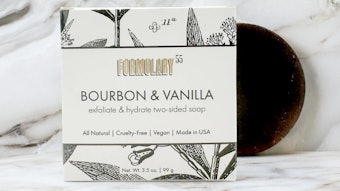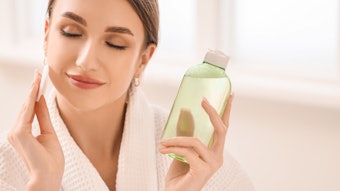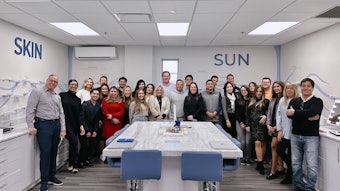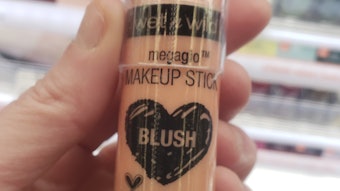
For years, people have used the science behind the microbiome to treat gut health issues. This is demonstrated by the consumption of prebiotics, postbiotics and probiotics in the form of food or supplements. Many skin care trends have stemmed from food trends—the skin care microbiome realm is one of them, and is well-established and backed by various articles and books.
Featured: The Bare Minimum: Skinimalism and the Microbiome
Microbiome skin care is not a new concept but this trend has been making a comeback thanks in part to TikTok. The pandemic also renewed interest in how we are preserving and protecting skin immunity with science-based skin care, and the industry has seen an influx of brands of various sizes launching skin care products that are marketed toward protecting the microbiome. Brands including Symbiome, Mother Dirt, Biophile and Osea, for example, have developed microbiome-based skin care products that contain prebiotics, postbiotics and/or probiotics.
Consumers can find various forms of microbiome skin care in all product types, such as cleansers, serums, moisturizers, toners—seemingly anything. While the previous clean beauty movement is notoriously lacking in science, microbiome skin care has renewed consumer interest in understanding the science of skin care.1
The Skin Ecosystem
Understanding how the skin's microbiome works is vital in creating an effective formula. Like the gut, the skin has an ecosystem that contains bacteria, fungi and viruses that make up the skin's microbiome. Cutibacterium acnes (C. acnes) (formerly Propionibacterium acnes) is the bacteria involved in acne formation, and the main thought is to remove this bacterium from the surface of the skin, which would in turn reduce acne flare-ups.
However, when attempting to remove C. acnes from the surface of the skin, other vital microorganisms may be removed that help to maintain the skin's barrier and health. As consumers become educated about how maintaining the skin's ecosystem creates healthy, radiant skin, adding bacteria to the surface of skin is not as scary to consumers.
The current microbiome skin care market has four main ways to maintain the skin's microbiome:
- Removing pathogenic bacteria;
- Adding prebiotics that feeds the good bacteria;
- Adding probiotics, which adds good bacteria; and
- Implementing postbiotics, which adds by-products of bacteria to the skin.
The most popular approaches are creating prebiotic and probiotic skin care products, which are the most familiar to consumers thanks to food trends and makes them more easily translatable in skin care.2
C. acnes
Human skin is different amongst everyone; some have dry skin, oily skin, etc. Understanding how certain microorganisms can affect the way skin looks and feels is pertinent in attempting to heal the skin with a microbiome-based approach. As previously mentioned, C. acnes is associated with acne; although having a clear understanding of how this bacterium works can affect the formulation approach.
Related: StratiCELL Expands MicroBIOS Platform to Test C. acnes
C. acnes often inhabits the sebaceous hair follicle, where it survives in an environment alongside a plethora of antimicrobial peptides. It is incredibly robust and abundant on the skin. C. acnes can positively contribute to the skin's overall health by supporting its defenses both directly, by producing the antimicrobial peptide cutimycin,3 and indirectly, with fermentation products.4
Additionally important is its autophagy-stimulating capability,5 an essential cellular process involved in everything from skin aging to cancer.6, 7 C. acnes also induces sebum production through its metabolites8 to amend unusual cases of skin itch9 and acts an important pillar in skin’s antioxidant defense.10, 11
However, C. acnes is not necessarily a good bacterium for everyone, as it can cause excess sebum production that leads to acne in certain age groups and skin types. Specific consumer groups to treat for C. acnes would include teenagers and men, as they are known to produce more sebum, as well as those who would categorize themselves in the acne-prone and oily skin category.12
S. epidermidis
Staphylococcus epidermidis (S. epidermidis) is an abundant bacterial colonizer in human skin and recent studies have found that specific strains of it can help or harm the skin barrier. S. epidermidis activates distinct innate immune signaling pathways in human keratinocytes to augment antimicrobial peptides. It can weaken the inflammatory response to accelerate wound healing. Some strains of S. epidermidis can also dampen S. aureus, an induced neutrophil and pro-inflammatory cytokine production that allows for more protection against skin infection.
S. epidermidis is vital to creating adaptive defenses against pathogens and promoting homeostasis. It may be disadvantageous to the host under certain conditions, however; either genetic mutation or physical disruption can dramatically alter how S. epidermidis behaves. Those suffering from atopic dermatitis are known to be colonized by S. aureus but atopic dermatitis can also be colonized by S. epidermidis at lesion sites and this overgrown bacterium can lead to increased severity in the disease.
Some research has found that S. epidermidis forms biofilms that may exacerbate atopic dermatitis that can cause an inflammatory biofilm community of both S. aureus and S. epidermidis in sweat glands at atopic dermatitis lesion sites. However, it is still unclear to what extent S. epidermidis biofilms form on normal or diseased skin, and more work is needed to fully understand the impact of biofilms on atopic dermatitis or other skin diseases.13
Ingredients
A few ingredients that are known to help with maintaining the skin's ecosystems include lactobacillus ferment lysate, Bifida ferment filtrate, saccharomyces lysate and bacillus ferment. Every ingredient operates on a different mechanism of action. It is important for the formulator to comprehend how each ingredient works to effectively develop a formula for the skin.
As previously mentioned, understanding how the selected ingredient affects this skin is vital to ensure the formula is positively affecting the skin. Generally, these types of ingredients should be incorporated below 40°C - 45°C and at the end of an emulsion to ensure viability and stability. Formulators should furthermore limit alcohol content to below 50%, along with not directly adding these types of ingredients to strongly acidic or alkali systems.
Additionally, with any active that is healing the skin, it can cause a bit of irritation. The use of emollient is ideal. Emollients are oils and lipids that help to protect and lubricate the skin and enhance skin softness. Emollients fill any voids in the intracellular lipid matrix, which further allows for hydrated-looking skin. Some examples of emollients include Avena sativa (Oat) kernel oil, isopropyl myristate, Helianthus annuus (sunflower) seed oil, ethylhexyl palmitate and Prunus amygdalus dulcis (sweet almond) oil.
Conclusion
The two bacteria mentioned in this article are just two of many microorganisms that are present on the skin, which further concludes the need to understand how different microorganisms work and how they affect the skin is vital in formulating.
C. acnes and S. epidermidis are both abundant bacteria found on the skin, and have a strong influence on how the skin acts and how it fights back, whether that be with sebum production or wound healing abilities. When selecting a raw material that works to maintain the skin's microbiome, it is important to understand what aspect of the skin the product is trying to target when it comes to skin health and treatment.
As this trend makes a stronger presence in the skin care world, is important for the formulator to take the time to review each mechanism of action of not only the raw material but the bacterium affected. It is important to understand what the products are trying to target to ensure it's effective and not causing more harm than good.
Previous "Formulating on Trend:" Glow Serum
References
1. Mustafa, T. (2021, Aug 12). ‘Microbiome’ health is the latest skincare trend you’re going to hear more about. Metro.co.uk. Available at: https://metro.co.uk/2021/08/12/microbiome-health-is-the-latest-skincare-buzz-word-15079798/
2. DSM. The skin microbiome: a new dimension in skin health and beauty care. Available at: https://bit.ly/3q7vwzc
3. Claesen, J., et al. (2020). A Cutibacterium acnes antibiotic modulates human skin microbiota composition in hair follicles. Science Translational Medicine 12(570). Available at: https://doi.org/10.1126/scitranslmed.aay5445
4. Shu, M., et al. (2013, Feb 6). Fermentation of Propionibacterium acnes, a commensal bacterium in the human skin microbiome, as skin probiotics against methicillin-resistant Staphylococcus aureus. PLoS One. Available at: https://doi.org/10.1371/journal.pone.0055380
5. Megyeri, K., et al. (2018). Propionibacterium acnes induces autophagy in keratinocytes: Involvement of multiple mechanisms. J Invest Derma. Available at: https://doi.org/10.1016/j.jid.2017.11.018
6. Eckhart, L., Tschachler, E. and Gruber, F. (2019). Autophagic control of skin aging. Frontiers in Cell and Developmental Biology 7. Available at: https://doi.org/10.3389/fcell.2019.00143
7. Dikic, I. and Elazar, Z. (2018). Mechanism and medical implications of mammalian autophagy. Nature Reviews Molecular Cell Biology. Available at: https://doi.org/10.1038/s41580-018-0003-4
8. Iinuma, K., et al. (2009). Involvement of Propionibacterium acnes in the augmentation of lipogenesis in hamster sebaceous glands in vivo and in vitro. J Invest Derma. Available at: https://doi.org/10.1038/jid.2009.46
9. Keshari, S., et al. (2020). Skin Cutibacterium acnes mediates fermentation to suppress the calcium phosphate-induced itching: A butyric acid derivative with potential for Uremic Pruritus. J Clinic Med. Available at: https://doi.org/10.3390/jcm9020312
10. Allhorn, M., Arve, S., Brüggemann, H. and Lood, R. (2016). A novel enzyme with antioxidant capacity produced by the ubiquitous skin colonizer Propionibacterium acnes. Sci Reports. Available at: https://doi.org/10.1038/srep36412
11. Andersson, T., et al. (2019). Common skin bacteria protect their host from oxidative stress through secreted antioxidant RoxP. Sci Reports. Available at: https://doi.org/10.1038/s41598-019-40471-3
12. Paetzold, B., Brillet, F., Richardson. M.C. and Steventon, K. (2021, May). C. acnes Assist: Evolving Skin Care for Changing Needs, A Commentary.* Cosmet Toilet 136(5) 33-DM12. Available at: https://cosmeticsandtoiletries.texterity.com/cosmeticsandtoiletries/may_2021/MobilePagedArticle.action?articleId=1681597&app=false#articleId1681597
13. Brown, M. M. and Horswill, A. R. (2020). Staphylococcus epidermidis-Skin friend or foe? PLoS pathogens 16(11) e1009026. Available at: https://doi.org/10.1371/journal.ppat.1009026










